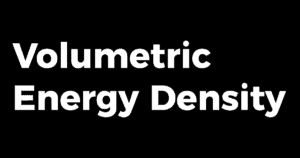
One of the most crucial aspects of battery performance is energy, which dictates how long your smartphone can run or how far you can drive an electric car. The energy density of a battery, or the amount of energy it can hold relative to its size or weight, is one of the most important metrics for evaluating battery quality.
Batteries with a higher energy density are more useful in situations where weight or space are critical because they can hold more energy in a lighter or smaller package.

The fact that battery energy density can be measured both by volume and by weight is an important concept to grasp. Even though they are occasionally confused, they are different and provide us with different insights into the battery’s properties.

The quantity of energy that can be contained in a specific physical volume is crucial for volume-constrained applications where available space is crucial.
Excellent examples where a high volumetric energy density is preferred:
Furthermore, even though SUVs and pickup trucks are already large, their lower aerodynamic efficiency means that their range may not be sufficient for every driver.
The battery cells themselves must fit more energy into the available space because the cars and vehicles themselves cannot simply be made larger to accommodate more batteries. Better volumetric energy density is a higher priority for these use cases, even though weight is still significant.
For use in aerospace or drone applications, weight is critical. In these situations, a larger battery may be supported by well-designed components; however, weight always limits performance, so the lighter the battery, the better. In severe situations, like satellite batteries, each kilogram of additional weight increases the launch cost by thousands of euros.
Excellent examples where a high gravimetric energy density (specific energy density) is preferred:
Other applications exist as well, albeit with more conventional limitations. For instance, there are legally mandated maximum weight restrictions in heavy-duty trucking to prevent damaging roads. The math is easy for a semi-truck: the less weight that the batteries take up, the more payload it can carry and the more money it can make in a single trip. Lighter cars handle better in other use cases, such as high-performance sports cars.

Definition of Research Batteries (by Swissbattery.com)
Research batteries are novel types of batteries which are not on the market. Often such Batteries have a low technical maturity and will not work properly in the real world (outside the laboratory). They often have a technology readiness level (TRL) between 3-7.
A battery that you can purchase in the store has a TRL of 9 ( occasionally a TRL of 8).
Examples of research batteries are Solid-Sate-batteries from companies and Universities.

The holy grail of battery energy storage is a high-energy density. Why is this?
This is a matter of size, volume and cost!
We want the battery to be small. This can be achieved with a high-energy density.
More importantly, we want the cost of energy storage to be affordable and low as possible. That means the stored kWh per unit should cost little.
The ED describes the amount of energy that can be stored in a battery per mass or per volume.
Thus, the amount of energy per kg in Wh/kg or the amount of energy per liter in Wh/L.
Some people call the energy density in short as “Energy” like the “specific energy”. However, this can be confusing as the therm energy in physics has a different meaning.
An ED number does not provide information on how quickly this energy can be used!
This knowledge is contained in a batteries’ power density, which describes the rate at which its energy can be put out.
This knowledge is contained in a batteries’ power density, which describes the rate at which its energy can be put out.
Typically, having a high-energy density goes along with a low-power density.
Energy density and power density differ in one important way – while battery energy density measures the watt-hours (wh) per kilogram mass (kg), power density measures the watt output per kilogram mass.
This is where power vs. energy comes into play. Power density measures how fast energy can be delivered, while ED measures how much energy a battery holds.
If a battery contains more energy, it can also release more energy. In a controlled or uncontrolled way!
The liquid electrolytes in lithium-ion batteries are flammable and can ignite, posing a safety hazard.
That’s why batteries are designed with safety features that have, however, a negative impact on ED and cost.
When it comes to high-ED, lithium-ion accumulators are the undisputed leader. They have changed our world with advances in energy consumption and portability.
The ED of the best commercial high-end lithium-ion battery (bare cell density) is between 250 Wh/kg and 265 Wh/kg (2023).
The lithium-ion battery with currently the highest ED is the lithium-ion NMC battery. It uses NMC 811 as the cathode and graphite carbon enriched with silicon as the anode.
Solid-sate batteries promise extreme high-ED in the future.